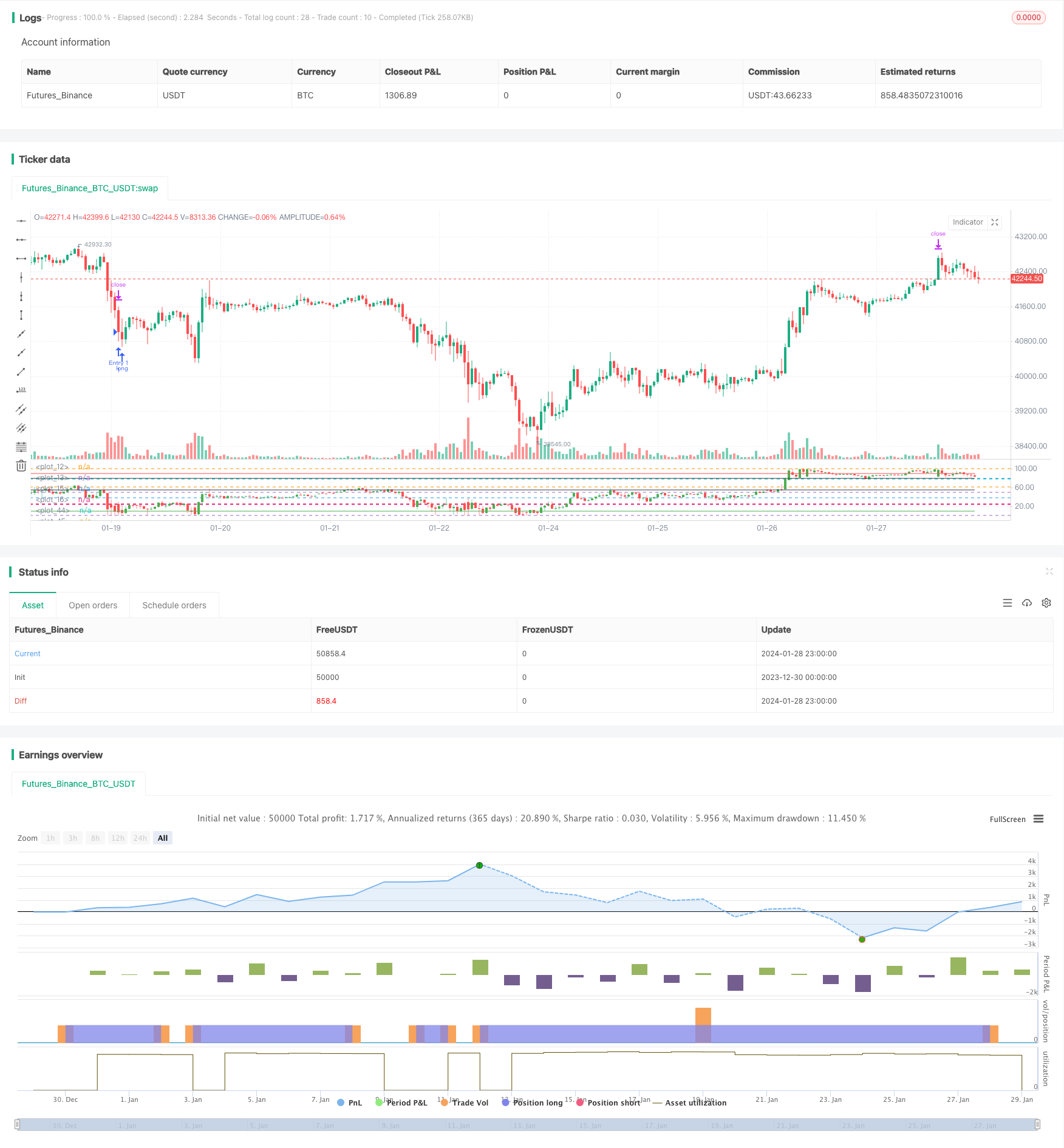
概述
本文主要介绍了一个基于相对强弱指标(RSI)设计的股票交易双向金字塔策略。该策略通过RSI指标判断股票超买超卖区域,配合金字塔加仓原理实现盈利。
策略原理
- 使用RSI指标判断股票是否进入超买超卖区域。RSI低于25时为超卖,高于80时为超买。
- 当RSI进入超卖区域时,开始做多入场。当RSI进入超买区域时,开始做空入场。
- 采用金字塔加仓方式,最多加仓7次。每次加仓后设置止盈止损点。
优势分析
- 使用RSI指标判断超买超卖面积,可以捕捉较大的价格反转机会。
- 金字塔加仓方式可以在行情正确时获取较优的收益率。
- 每次加仓后设置止盈止损,可以控制风险。
风险分析
- RSI指标判断超买超卖的效果不稳定,可能出现错误信号。
- 需要合理设置加仓次数,加仓过多风险会增加。
- 停止损失点设置需要考虑波动率,不能设置过小。
优化方向
- 可以考虑结合其他指标过滤RSI信号,提高判断超买超卖的准确率。例如KDJ、BOLL等指标的配合。
- 可以设置浮动止损来跟踪价格。根据波动率和风险控制要求动态调整。
- 可以考虑根据市场状况(牛市、熊市等)使用自适应参数。
总结
本策略将RSI指标与金字塔加仓策略结合,在判断超买超卖的同时可以通过加仓获取更多收益。虽然RSI判断准确性有待提高,但通过合理的参数优化,结合其他指标可以形成效果稳定的交易策略。该策略具有一定的普适性,是一种相对简单直接的量化交易方法。
策略源码
/*backtest
start: 2023-12-30 00:00:00
end: 2024-01-29 00:00:00
period: 1h
basePeriod: 15m
exchanges: [{"eid":"Futures_Binance","currency":"BTC_USDT"}]
*/
//@version=4
// This source code is subject to the terms of the Mozilla Public License 2.0 at https://mozilla.org/MPL/2.0/
// © RafaelZioni
strategy(title='Simple RSI strategy', overlay=false)
SWperiod = 1
look = 0
OverBought = input(80, minval=50)
OverSold = input(25, maxval=50)
bandmx = hline(100)
bandmn = hline(0)
band1 = hline(OverBought)
band0 = hline(OverSold)
//band50 = hline(50, color=black, linewidth=1)
fill(band1, band0, color=color.purple, transp=98)
src = close
len = input(5, minval=1, title="RSI Length")
up = rma(max(change(src), 0), len)
down = rma(-min(change(src), 0), len)
rsi = down == 0 ? 100 : up == 0 ? 0 : 100 - 100 / (1 + up / down)
p = 100
//scale
hh = highest(high, p)
ll = lowest(low, p)
scale = hh - ll
//dynamic OHLC
dyno = (open - ll) / scale * 100
dynl = (low - ll) / scale * 100
dynh = (high - ll) / scale * 100
dync = (close - ll) / scale * 100
//candle color
color_1 = close > open ? 1 : 0
//drawcandle
hline(78.6)
hline(61.8)
hline(50)
hline(38.2)
hline(23.6)
plotcandle(dyno, dynh, dynl, dync, title="Candle", color=color_1 == 1 ? color.green : color.red)
plot(10, color=color.green)
plot(55, color=color.black)
plot(80, color=color.black)
plot(90, color=color.red)
long = rsi <= OverSold ? 5 : na
//Strategy
golong = rsi <= OverSold ? 5 : na
longsignal = golong
//based on https://www.tradingview.com/script/7NNJ0sXB-Pyramiding-Entries-On-Early-Trends-by-Coinrule/
//set take profit
ProfitTarget_Percent = input(3)
Profit_Ticks = close * (ProfitTarget_Percent / 100) / syminfo.mintick
//set take profit
LossTarget_Percent = input(10)
Loss_Ticks = close * (LossTarget_Percent / 100) / syminfo.mintick
//Order Placing
strategy.entry("Entry 1", strategy.long, when=strategy.opentrades == 0 and longsignal)
strategy.entry("Entry 2", strategy.long, when=strategy.opentrades == 1 and longsignal)
strategy.entry("Entry 3", strategy.long, when=strategy.opentrades == 2 and longsignal)
strategy.entry("Entry 4", strategy.long, when=strategy.opentrades == 3 and longsignal)
strategy.entry("Entry 5", strategy.long, when=strategy.opentrades == 4 and longsignal)
strategy.entry("Entry 6", strategy.long, when=strategy.opentrades == 5 and longsignal)
strategy.entry("Entry 7", strategy.long, when=strategy.opentrades == 6 and longsignal)
if strategy.position_size > 0
strategy.exit(id="Exit 1", from_entry="Entry 1", profit=Profit_Ticks, loss=Loss_Ticks)
strategy.exit(id="Exit 2", from_entry="Entry 2", profit=Profit_Ticks, loss=Loss_Ticks)
strategy.exit(id="Exit 3", from_entry="Entry 3", profit=Profit_Ticks, loss=Loss_Ticks)
strategy.exit(id="Exit 4", from_entry="Entry 4", profit=Profit_Ticks, loss=Loss_Ticks)
strategy.exit(id="Exit 5", from_entry="Entry 5", profit=Profit_Ticks, loss=Loss_Ticks)
strategy.exit(id="Exit 6", from_entry="Entry 6", profit=Profit_Ticks, loss=Loss_Ticks)
strategy.exit(id="Exit 7", from_entry="Entry 7", profit=Profit_Ticks, loss=Loss_Ticks)